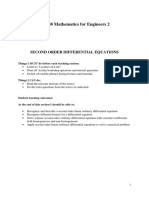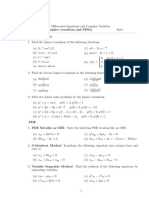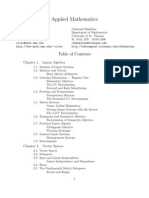Gauss Jordan Practice
Uploaded by
dibyodibakarGauss Jordan Practice
Uploaded by
dibyodibakarSolutions of Linear Systems by the Gauss-Jordan Method
The Gauss Jordan method allows us to isolate the coecients of a system of
linear equations making it simpler to solve for.
Creating the Augmented Matrix
To isolate the coecients of a system of linear equations we create an augmented
matrix as follows:
_
_
_
a
1
x + b
1
y + c
1
z = d
1
a
2
x + b
2
y + c
2
z = d
2
a
3
x + b
2
y + c
3
z = d
3
becomes
_
_
a
1
b
1
c
1
d
1
a
2
b
2
c
2
d
2
a
3
b
3
c
3
d
3
_
_
.
Exercise Represent the following systems of linear equations by an augmented
matrix:
(1)
_
_
_
x + z = 6
x + 2z + 6y = 9
x 4y z = 5
(2)
_
_
_
2x + 3z = y
5x + z = 3 + 2y
x + 6y + z = 9
Exercise Construct the system of linear equations from the augmented ma-
tricies
(1)
_
_
2 0 1
3 9 2
2 4 0
_
_
.
(2)
_
1 1 0 7
4 3 2 1
_
.
Row Operations
We can manipulate an augmented matrix using the following rules:
(1) Switch any two rows.
(2) Multiply a row by a nonzero real number.
(3) Adding a nonzero multiple of one row to any other row.
Exercise Rewrite the given augmented matrix according to the row operations
specied.
_
_
2 3 1 1
3 2 1 3
1 0 1 2
_
_
.
1
(1) R
1
+ 2R
2
R
1
(2) Switch rst and second row, and R
1
2R
3
R
3
.
Gauss Jordan Method
(1) Write system of equations so that variables are on the right side of the
equals sign.
(2) Write the augmented matrix for the system of equations
(3) Use the row operations to rewrite the augmented matrix so that the rst
row looks like:
[1 0 0 0 | a
1
]
(3) Use the row operations to rewrite the augmented matrix so that the second
row looks like:
[0 1 0 0 | a
1
]
(4) Continue this process for as long as you can.
2
Example Solve the following system of linear equations using the Gauss Jordan
method.
_
_
_
3x + 5y = z
4x z = 1 2y
7x + 4y + z = 1
3
Check Your Answers !!!
Insert the values that you calculated for x, y and z to check that the system of
linear euqations hold.
Solving a system of equations with an innite number of solutions
Example Solve the following system of linear equations using the Gauss Jordan
method.
_
_
_
4x 3y + z = 21 w
2x y + 2z + 7w = 2
10x = 15 + 5z + 20w
4
Solution:
What does this mean?
5
Addition and Subtraction of Matricies
Denition We say that the following matrix is an n m matrix
_
_
a
11
a
12
a
1m
a
21
a
22
a
2m
. .
. .
. .
a
n1
a
n2
a
nm
_
_
.
Describe the following matrices.
(1)
_
_
2 5 6
0 4 0
9 1 4
_
_
(2)
_
_
3
0
1
0
_
_
(3)
_
_
5 4
0 0
4 1
_
_
(2)
_
1 1 0 8 5
Deniton Two matricies are equal if they are of the same size and have similar
coresponding elements.
Example Do there exist values that make the following matricies equal? If so,
what are the values? If not, why not?
(1)
_
_
3 7 0 1
4 3 1 0
5 6 1 1
_
_
and
_
_
x 7 0 1
4 y 1 z
5 6 1 1
_
_
(2)
_
2 1 0
3 1 1
_
and
_
_
2 1 x
3 y 1
3 1 1
_
_
Adding Matrices
To add two matricies which have the same size you do the following operation
_
_
a
11
a
12
a
1m
a
21
a
22
a
2m
. .
. .
. .
a
n1
a
n2
a
nm
_
_
+
_
_
b
11
b
12
b
1m
b
21
b
22
b
2m
. .
. .
. .
b
n1
b
n2
b
nm
_
_
=
_
_
a
11
+ b
11
a
12
+ b
12
a
1m
+ b
1m
a
21
+ b
21
a
22
+ b
22
a
2m
+ b
2m
. .
. .
. .
a
n1
+ b
n1
a
n2
+ b
n2
a
nm
+ b
nm
_
_
.
YOU CAN ONLY ADD MATRICES OF THE SAME SIZE!
6
Notation:
If
A =
_
_
a
11
a
12
a
1m
a
21
a
22
a
2m
. .
. .
. .
a
n1
a
n2
a
nm
_
_
and B =
_
_
b
11
b
12
b
1m
b
21
b
22
b
2m
. .
. .
. .
b
n1
b
n2
b
nm
_
_
then
A + B =
_
_
a
11
+ b
11
a
12
+ b
12
a
1m
+ b
1m
a
21
+ b
21
a
22
+ b
22
a
2m
+ b
2m
. .
. .
. .
a
n1
+ b
n1
a
n2
+ b
n2
a
nm
+ b
nm
_
_
.
Multiplying a matrix by a constant: If A is the matrix above and k is a
constant then
kA =
_
_
ka
11
ka
12
ka
1m
ka
21
ka
22
ka
2m
. .
. .
. .
ka
n1
ka
n2
ka
nm
_
_
Subtracting Matrices
Let A and B be the matrices describes above, then
AB = A + (B).
Examples Preform the Following operations if they are possible. If it is not
possible, please explain why.
(1)
_
2 1 0
3 1 1
_
+
_
3 1 0
1 2 1
_
=
(2)
_
_
1
3
4
1
0
_
_
+
_
4 1 0 2 2
=
7
(4) 2
_
_
3 0 1
0 4 1
5 2 1
_
_
=
(3)
_
_
3 0 1
0 4 1
5 2 1
_
_
_
_
2 1 0
1 2 1
8 10 1
_
_
=
(4)
_
_
2 1 1
10 4 1
8 2 3
_
_
_
2 5 7
1 12 0
_
=
Denition The zero matrix is any matrix with all its entries equal to 0.
0 =
_
_
0 0 0
0 0 0
. . .
. . .
. . .
0 0 0
_
_
Denition The additive inverse of a matrix A, is the matrix B, such that
A + B = 0.
NOTE: This implies that the additive inverse of A is A.
Exercise Find the additive inverses of the following matricies.
(1)
_
3 2
1 0
_
(2) 2
_
1 0 3
3 5 1
_
(3)
_
_
2 5
0 3
1 1
1 3
_
_
8
You might also like
- Ablowitz M. J. & Fokas A. S. - Complex Variables (2003) ErrataNo ratings yetAblowitz M. J. & Fokas A. S. - Complex Variables (2003) Errata8 pages
- The Fundamental Theorem of Calculus and The Poincaré LemmaNo ratings yetThe Fundamental Theorem of Calculus and The Poincaré Lemma13 pages
- Loss of Mains Detection For Embedded Generation by System Impedance MonitoringNo ratings yetLoss of Mains Detection For Embedded Generation by System Impedance Monitoring4 pages
- Linear Algebra Matrices, Vectors, Determinants. Linear SystemsNo ratings yetLinear Algebra Matrices, Vectors, Determinants. Linear Systems53 pages
- Numerical Linear Algebra University of Edinburgh Past Paper 2020-2021100% (1)Numerical Linear Algebra University of Edinburgh Past Paper 2020-20214 pages
- Practice Questions of ODE's Numerical Solution: Y, y X DX DyNo ratings yetPractice Questions of ODE's Numerical Solution: Y, y X DX Dy2 pages
- Topic 3-Part 1-Poles-and-Zeros-of-Transfer-Function.-Pole-Zero-MapNo ratings yetTopic 3-Part 1-Poles-and-Zeros-of-Transfer-Function.-Pole-Zero-Map23 pages
- End Sem Exam TA201 20170923 Final SolutionNo ratings yetEnd Sem Exam TA201 20170923 Final Solution5 pages
- A Second Course in Elementary Differential Equations PDFNo ratings yetA Second Course in Elementary Differential Equations PDF201 pages
- Gauss Elmination and Gauss Jordan Operations CountNo ratings yetGauss Elmination and Gauss Jordan Operations Count33 pages
- Simple Fixed Point Iteration Method PDFNo ratings yetSimple Fixed Point Iteration Method PDF11 pages
- Solve 3 Simultaneous Equation Using Inverse MethodNo ratings yetSolve 3 Simultaneous Equation Using Inverse Method23 pages
- Functions of Matrices Nicholas J. Higham 2024 Scribd Download100% (1)Functions of Matrices Nicholas J. Higham 2024 Scribd Download71 pages
- ADOMIAN Decomposition Method For Solvin1No ratings yetADOMIAN Decomposition Method For Solvin118 pages
- Solutions To Rainville's Special Functions - Tom Cuchta, Leon Hall, Sylvester Pagano, Compiled 2 June 2015No ratings yetSolutions To Rainville's Special Functions - Tom Cuchta, Leon Hall, Sylvester Pagano, Compiled 2 June 2015187 pages
- 14 Fourier Integral Fourier Transform (Zill, Dennis G) ..No ratings yet14 Fourier Integral Fourier Transform (Zill, Dennis G) ..21 pages
- The Sum of The Eigenvalues of A Square Matrix Is Its TraceNo ratings yetThe Sum of The Eigenvalues of A Square Matrix Is Its Trace5 pages
- Introductory Applications of Partial Differential Equations: With Emphasis on Wave Propagation and DiffusionFrom EverandIntroductory Applications of Partial Differential Equations: With Emphasis on Wave Propagation and DiffusionNo ratings yet
- System of Linear Equations Direct MethodsNo ratings yetSystem of Linear Equations Direct Methods21 pages
- Cpe-310B Engineering Computation and Simulation: Solving Sets of EquationsNo ratings yetCpe-310B Engineering Computation and Simulation: Solving Sets of Equations46 pages
- Scanning Electron Microscopy of Fracture Surfaces of Carbon Composite MaterialsNo ratings yetScanning Electron Microscopy of Fracture Surfaces of Carbon Composite Materials34 pages
- Scanning Electron Microscopy: A Lecture To Participate in Microteaching Session #2No ratings yetScanning Electron Microscopy: A Lecture To Participate in Microteaching Session #28 pages
- Dekha Alor Na Dekha Rup by Muhammad Jafar Iqbal PDF100% (1)Dekha Alor Na Dekha Rup by Muhammad Jafar Iqbal PDF64 pages
- Synthesis and Structure Refinement of Zinc-Doped B-TricalciumNo ratings yetSynthesis and Structure Refinement of Zinc-Doped B-Tricalcium4 pages
- Am J Physiol Cell Physiol 2001 Yamaguchi C382 93No ratings yetAm J Physiol Cell Physiol 2001 Yamaguchi C382 9313 pages
- LU Decomposition: (Chapter 20, Section 20.2 Kreyszig)No ratings yetLU Decomposition: (Chapter 20, Section 20.2 Kreyszig)3 pages
- G11-Maths Practice Questions From Unit 1-8No ratings yetG11-Maths Practice Questions From Unit 1-834 pages
- Download Complete Higher Mathematics For Science And Engineering 1st Edition Aliakbar Montazer Haghighi PDF for All Chapters100% (1)Download Complete Higher Mathematics For Science And Engineering 1st Edition Aliakbar Montazer Haghighi PDF for All Chapters65 pages
- (Non-QU) Linear Algebra by DR - Gabriel Nagy PDFNo ratings yet(Non-QU) Linear Algebra by DR - Gabriel Nagy PDF362 pages
- CS211 Fall 2021 Programming Assignment II: David MenendezNo ratings yetCS211 Fall 2021 Programming Assignment II: David Menendez10 pages
- Applied Mathematics - John Wiley & SonsNo ratings yetApplied Mathematics - John Wiley & Sons1,165 pages
- Applied Optimization For Wireless, Machine Learning, Big DataNo ratings yetApplied Optimization For Wireless, Machine Learning, Big Data25 pages
- Integrated - Math 1.unit 5.unit AssessmentNo ratings yetIntegrated - Math 1.unit 5.unit Assessment6 pages
- Full Download Numerical and Statistical Methods for Civil Engineering Gujarat Technological University 2017 2nd Edition Ravish R Singh PDF DOCX100% (1)Full Download Numerical and Statistical Methods for Civil Engineering Gujarat Technological University 2017 2nd Edition Ravish R Singh PDF DOCX57 pages
- Applied Mathematics-I (MATH114) : Lecture1: Introduction and Basic of MatricesNo ratings yetApplied Mathematics-I (MATH114) : Lecture1: Introduction and Basic of Matrices15 pages
- (APR2019) MATB253-MATB2014 Course Outline (NEW)No ratings yet(APR2019) MATB253-MATB2014 Course Outline (NEW)10 pages
- Mohammad Firdaus Bin Johari - 73569 - Tutorial 7 of Calculus and Linear AlgebraNo ratings yetMohammad Firdaus Bin Johari - 73569 - Tutorial 7 of Calculus and Linear Algebra7 pages
- Chapter 2: Matrices: Ecemath - Advanced Engineering Mathematics For ECENo ratings yetChapter 2: Matrices: Ecemath - Advanced Engineering Mathematics For ECE4 pages
- Mm597 Advanced Numerical Methods in EngineersNo ratings yetMm597 Advanced Numerical Methods in Engineers142 pages
- OT_Ch02 Matrix Algebra and Its ApplicationNo ratings yetOT_Ch02 Matrix Algebra and Its Application18 pages
- Ablowitz M. J. & Fokas A. S. - Complex Variables (2003) ErrataAblowitz M. J. & Fokas A. S. - Complex Variables (2003) Errata
- The Fundamental Theorem of Calculus and The Poincaré LemmaThe Fundamental Theorem of Calculus and The Poincaré Lemma
- Loss of Mains Detection For Embedded Generation by System Impedance MonitoringLoss of Mains Detection For Embedded Generation by System Impedance Monitoring
- Linear Algebra Matrices, Vectors, Determinants. Linear SystemsLinear Algebra Matrices, Vectors, Determinants. Linear Systems
- Numerical Linear Algebra University of Edinburgh Past Paper 2020-2021Numerical Linear Algebra University of Edinburgh Past Paper 2020-2021
- Practice Questions of ODE's Numerical Solution: Y, y X DX DyPractice Questions of ODE's Numerical Solution: Y, y X DX Dy
- Topic 3-Part 1-Poles-and-Zeros-of-Transfer-Function.-Pole-Zero-MapTopic 3-Part 1-Poles-and-Zeros-of-Transfer-Function.-Pole-Zero-Map
- A Second Course in Elementary Differential Equations PDFA Second Course in Elementary Differential Equations PDF
- Gauss Elmination and Gauss Jordan Operations CountGauss Elmination and Gauss Jordan Operations Count
- Solve 3 Simultaneous Equation Using Inverse MethodSolve 3 Simultaneous Equation Using Inverse Method
- Functions of Matrices Nicholas J. Higham 2024 Scribd DownloadFunctions of Matrices Nicholas J. Higham 2024 Scribd Download
- Solutions To Rainville's Special Functions - Tom Cuchta, Leon Hall, Sylvester Pagano, Compiled 2 June 2015Solutions To Rainville's Special Functions - Tom Cuchta, Leon Hall, Sylvester Pagano, Compiled 2 June 2015
- 14 Fourier Integral Fourier Transform (Zill, Dennis G) ..14 Fourier Integral Fourier Transform (Zill, Dennis G) ..
- The Sum of The Eigenvalues of A Square Matrix Is Its TraceThe Sum of The Eigenvalues of A Square Matrix Is Its Trace
- Introductory Applications of Partial Differential Equations: With Emphasis on Wave Propagation and DiffusionFrom EverandIntroductory Applications of Partial Differential Equations: With Emphasis on Wave Propagation and Diffusion
- Cpe-310B Engineering Computation and Simulation: Solving Sets of EquationsCpe-310B Engineering Computation and Simulation: Solving Sets of Equations
- Scanning Electron Microscopy of Fracture Surfaces of Carbon Composite MaterialsScanning Electron Microscopy of Fracture Surfaces of Carbon Composite Materials
- Scanning Electron Microscopy: A Lecture To Participate in Microteaching Session #2Scanning Electron Microscopy: A Lecture To Participate in Microteaching Session #2
- Dekha Alor Na Dekha Rup by Muhammad Jafar Iqbal PDFDekha Alor Na Dekha Rup by Muhammad Jafar Iqbal PDF
- Synthesis and Structure Refinement of Zinc-Doped B-TricalciumSynthesis and Structure Refinement of Zinc-Doped B-Tricalcium
- LU Decomposition: (Chapter 20, Section 20.2 Kreyszig)LU Decomposition: (Chapter 20, Section 20.2 Kreyszig)
- Download Complete Higher Mathematics For Science And Engineering 1st Edition Aliakbar Montazer Haghighi PDF for All ChaptersDownload Complete Higher Mathematics For Science And Engineering 1st Edition Aliakbar Montazer Haghighi PDF for All Chapters
- CS211 Fall 2021 Programming Assignment II: David MenendezCS211 Fall 2021 Programming Assignment II: David Menendez
- Applied Optimization For Wireless, Machine Learning, Big DataApplied Optimization For Wireless, Machine Learning, Big Data
- Full Download Numerical and Statistical Methods for Civil Engineering Gujarat Technological University 2017 2nd Edition Ravish R Singh PDF DOCXFull Download Numerical and Statistical Methods for Civil Engineering Gujarat Technological University 2017 2nd Edition Ravish R Singh PDF DOCX
- Applied Mathematics-I (MATH114) : Lecture1: Introduction and Basic of MatricesApplied Mathematics-I (MATH114) : Lecture1: Introduction and Basic of Matrices
- Mohammad Firdaus Bin Johari - 73569 - Tutorial 7 of Calculus and Linear AlgebraMohammad Firdaus Bin Johari - 73569 - Tutorial 7 of Calculus and Linear Algebra
- Chapter 2: Matrices: Ecemath - Advanced Engineering Mathematics For ECEChapter 2: Matrices: Ecemath - Advanced Engineering Mathematics For ECE






































































































